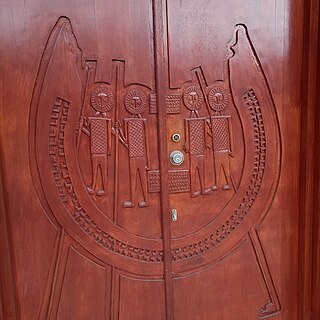In Mandaeism, Ptahil also known as Ptahil-Uthra, is the Fourth Life, the third of three emanations from the First Life, Hayyi Rabbi, after Yushamin and Abatur. Ptahil-Uthra alone does not constitute the demiurge but only fills that role since he is viewed as the creator of the material world in the Ginza Rabba, often holding an inherently malicious character.
An uthra or ʿutra is a "divine messenger of the light" in Mandaeism. Charles G. Häberl and James F. McGrath translate it as "excellency". Jorunn Jacobsen Buckley defines them as "Lightworld beings, called 'utras ." Aldihisi (2008) compares them to the yazata of Zoroastrianism. According to E. S. Drower, "an 'uthra is an ethereal being, a spirit of light and Life."
Mandaean cosmology is the Gnostic conception of the universe in the religion of Mandaeism.
In Mandaeism, Yushamin and also known as the 'Second Life', is the primal uthra and a subservient emanation who was created by the Mandaean God 'The Great Life', hence beginning the creation of the material world. Yushamin is the father of Abatur. Jorunn J. Buckley identifies Yushamin as "both a Lightworld utra beyond reproach and the prototype of a priest who has made mistakes in ritual."
In Mandaeism, Manda d-Hayyi or Manda ḏ-Hiia is an uthra sent by the Great Life as a messenger to John the Baptist. Manda d-Hayyi is considered to be the most important uthra, since he is the one bringing manda to Earth (Tibil).
In Mandaean cosmology, Tibil or occasionally Arqa ḏ-Tibil is the Earth (World) or earthly middle realm. It is separated from the World of Light above and the World of Darkness below by ayar (aether).
In Mandaeism, Hayyi Rabbi, 'The Great Living God', is the supreme God from which all things emanate.
In Mandaean cosmology, a maṭarta is a "station" or "toll house" that is located between the World of Light from Tibil (Earth). It has variously been translated as "watch-station", "toll-station", "way-station", or "purgatory". Maṭartas are guarded by various uthras and demons. Ruha, the queen of the underworld, is the ruler or guardian of one of the maṭartas.
In Mandaeism, Hibil or Hibil Ziwa is an uthra from the World of Light. Hibil is considered to be the Mandaean equivalent of Abel.
In Mandaeism, the World of Darkness is the underworld located below Tibil (Earth). It is ruled by its king Ur the Leviathan and its queen Ruha, mother of the seven planets and twelve constellations.
In Mandaeism, Adathan and Yadathan are a pair of uthras who stand at the Gate of Life in the World of Light, praising and worshipping Hayyi Rabbi. In the Ginza Rabba and Qulasta, they are always mentioned together. Book 14 of the Right Ginza mentions Adathan and Yadathan as the guardians of the "first river".
In Mandaeism, Shilmai or Shalmai (Šalmai) is an uthra who serves as one of the two guardian spirits of Piriawis, the heavenly yardna (river) in the World of Light. In the Ginza Rabba and Qulasta, he is usually mentioned together with Nidbai.
In Mandaeism, Nidbai is an uthra who serves as one of the two guardian spirits of Piriawis, the heavenly yardna (river) in the World of Light. In the Ginza Rabba and Qulasta, he is usually mentioned together with Shilmai.
In Mandaean cosmology, the Sea of Suf is a primordial sea in the World of Darkness. It is analogous to Tehom in the Book of Genesis. It is a great sea that the soul has to pass in the first steps of ascending, and is also considered to be the limit of worldly desire.
In Mandaean cosmology, Piriawis, also known as the Yardna Rabba, is the sacred life-giving river (yardna) of the World of Light. It is the heavenly counterpart of rivers on Earth (Tibil), which are considered by Mandaeans to be manifestations of the heavenly Piriawis.
In Mandaeism, Yawar Ziwa is an uthra from the World of Light. He is the personification of light.
In Mandaeism, Ṣaureil, also spelled Ṣauriel or Ṣaurʿil, is the angel of death. Ṣaureil features prominently in Book 1 of the Left Ginza as the angel who announces the message of death to Adam and Shitil (Seth).
In Mandaeism, Yufin-Yufafin or Yupin-Yupapin is an uthra in the World of Light. In the Ginza Rabba, Yufin-Yufafin is mentioned in Books 3 and 5.4 of the Right Ginza and Book 1 of the Left Ginza, whereas "Yufin-Uthra" is mentioned in Book 4 of the Right Ginza. He is also mentioned in many Qulasta prayers, including prayers 5, 9, 22, 28, 46, 77, 105, and 171, in which he is often mentioned along with uthras such as Sam Mana Smira and Nbaṭ.

In Mandaeism, Shahrat is a ship or boat mentioned in the Scroll of Abatur. Shahrat ferries souls from Tibil across the river Hitpun and into the house of Abatur. According to the Mandaean priest Brikha Nasoraia (2021), it is basically a "space-ship" traveling "faster than the speed of light" through ayar (ether) to higher realms.
In Mandaeism, Yasana is a heavenly gate in the World of Light. The term is mentioned in Chapter 12 of the Right Ginza, which describes it as "the great gate of Yasana, the place where a throne has been erected for the builder of the heaven and the earth".



